Centauri Dreams
Imagining and Planning Interstellar Exploration
Advancing the Search for Technosignatures
What a pleasure to see — after three decades — a grant from NASA for a SETI project, and on technosignatures at that. NASA’s history with SETI has been a challenging one given the subject’s reception in Congress. It was in 1971 that the agency funded Barney Oliver’s study on the huge array called Project Cyclops, whose price-tag would have been astronomical, but the report in which it was described provided numerous insights into the SETI effort. NASA’s engagement with SETI later came under fire from William Proxmire in the Senate, resulting in the termination of SETI funding in 1982. Proxmire would later change his mind on SETI’s value.
Even so, the NASA Microwave Observing Program (MOP) planned as a search of 800 nearby stars in the early 1990’s was again targeted in Congress and canceled shortly thereafter. The SETI effort developed in the ensuing years without government funding through efforts like Project Phoenix, which picked up the Mobile Observing Program under the guidance of Jill Tarter and the SETI Institute. With a number of interesting projects along the way, SETI has remained an ad hoc, privately funded effort in the US, with ongoing work through Breakthrough Listen, the Allen Telescope Array, the Berkeley SETI Research Center (SERENDIP) and others. The SETI League continues an energetic grassroots effort under the guidance of Paul Shuch. It’s interesting to note that in China, SETI is explicitly folded into the FAST radio observatory’s charter.
I haven’t gotten into optical SETI or other SETI projects in the US and abroad, but the point is that a new NASA grant makes a welcome return of NASA’s willingness to look at SETI, and with an eye toward the cutting-edge question of technosignatures as opposed to the reception of radio or optical signals. Here we’re talking about what might be created by advanced cultures, everything from vast Dyson spheres exploiting the host star’s energies to industrial pollution in exoplanet atmospheres, or even city lights. Exoplanet research motivates the current attention, says Adam Frank (University of Rochester), the primary recipient of the grant. Says Frank:
“The Search for Extraterrestrial Intelligence (SETI) has always faced the challenge of figuring out where to look. Which stars do you point your telescope at and look for signals? Now we know where to look. We have thousands of exoplanets including planets in the habitable zone where life can form. The game has changed.”
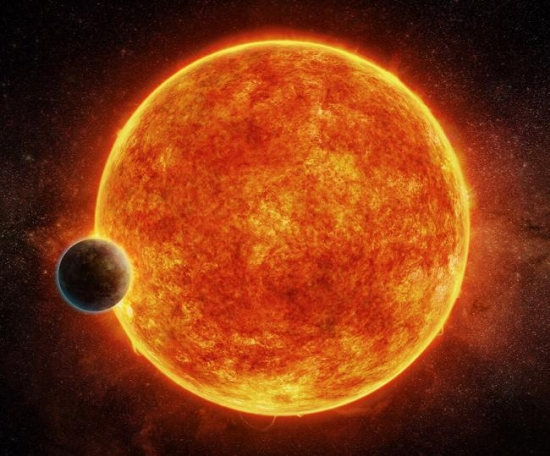
Image: Artist’s impression of the exoplanet LHS 1140b, which orbits its star within the “habitable zone” where liquid water might exist on the surface. The LHS 1140 system is only about 40 light-years from Earth, making it a possible target for studying the atmosphere of the planet if it has one. Credit: M. Weiss/CfA.
Called “Characterizing Atmospheric Technosignatures,” the new study will focus on solar panels and pollutants as indicators of technological activities. Avi Loeb (Harvard University) explains:
“The nearest star to Earth, Proxima Centauri, hosts a habitable planet, Proxima b. The planet is thought to be tidally locked with permanent day and night sides. If a civilization wants to illuminate or warm up the night side, they would place photovoltaic cells on the day side and transfer the electric power gained to the night side.”
What the study probes is how something like this would be detected if present, as a way of developing the mathematical and observational tools that can extend technosignature searches to various nearby stars. We are developing the ground- and space-based observatories with which this work can be conducted, but telescope time is precious, and knowing how and where to look is a critical issue. As we begin to be able to probe the atmospheres of rocky planets, we’ll have the potential for detecting not just biosignatures but evidence of artificially produced molecules that, like chlorofluorocarbons (CFCs), are unlikely to appear naturally.
Along with Harvard’s Loeb, Frank is joined in the effort by Penn State’s Jason Wright, Mansavi Lingam of the Florida Institute of Technology, and Jacob Haqq-Misra of Blue Marble Space. Out of the study, we can hope, will come quantitative information about how the project of technosignature detection can proceed. Let me recommend Frank’s The Light of the Stars (W. W. Norton & Company, 2018), along with Jason Wright’s Astrowright site for continuing insights into technosignatures. Also have a look at Wright’s Glimpsing Heat from Alien Technologies, published in these pages several years ago.

Planetary Days as a SETI Factor
Yesterday we looked at a new paper from Robert Gray on the possibility — even likelihood — that the kind of signal SETI is looking for would be intermittent in nature rather than continuous. The numbers tell the story: In Gray’s calculations, an isotropic transmission with a range of 1,000 light years — i.e., a continuous beacon broadcasting in all directions — requires on the order of 1015 W to produce the kind of signal-to-noise ratio that would allow us to pick it up with facilities like those used in current SETI searches.
1015 is a big number, going beyond the current terrestrial power consumption of 1013 W by orders of magnitude and reaching 1 percent of the total power received by Earth from the Sun. Reduce the desired range of the signal to 100 light years and the requirement for isotropic broadcasts is still daunting, demanding something like 1013 W, or 10,000 1,000 MW power plants. As Gray puts it:
The large power required for continuous isotropic broadcasts could conceivably be available to some very technologically advanced civilizations (Kardashev 1964, 1967), but assuming very advanced civilizations seems very optimistic.
Indeed. Hence the need to ponder alternatives. Consider the savings gained, for example, in using high-gain antenna systems to target single stars. Gray describes an Arecibo-class transmitting antenna following this strategy. Now the power requirement begins to fall to recognizable levels. An Arecibo-like transmitting antenna punching out a signal to a star 1,000 light years away needs 108 W, dropping to 106 W for a range of 100 light years. In other words, this we can do today with the actual Arecibo planetary radar.
Transmitting is one thing, reception quite another. If we think in terms of sending a signal to more than one target star, broadcasting to each in succession in a repetitive pattern, we are sending a signal that would obviously appear intermittent to any receiving station, and factors that are entirely unknown to us come into play. How often would such signals repeat? We would need to know the number of targets the transmitting civilization had chosen and the dwell time devoted to each. Any calculations we run fall victim to the depth of the imponderables here.
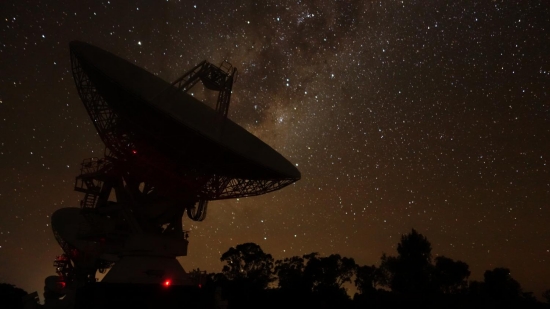
Image: Australia Telescope Compact Array (ATCA) antennas at night. Credit: Sascha Schediwy.
But there are a few numbers we might plug in to give us a sense of the possibilities. Gray’s paper looks at planetary rotation periods as an indicator. The thinking is that transmission from the surface of planets could make rotation a factor, rendering some signals periodic. In our own Solar System, we find a median day of 23.9 hours (dropping to 21.1 hours if we leave Pluto out). Three quarters of the eight planets have days in the range of 10-25 hours. Our knowledge of exoplanet days will grow with time, allowing us to get a sense of day length for the planets we are most interested in: Rocky planets in or near the habitable zone of stars other than our own.
Thus the ‘interstellar lighthouse,’ a directional transmission from a fixed antenna on a rotating planet producing an intermittent signal with the period of the planet’s sidereal day:
In the case of a source planet with the median day in our planetary system and a rotating 1° lune, distant observers would be illuminated for 23.9/360 = 0.0664 hours or 3.9 minutes every 23.9 hours. Such a signaling strategy would have the isotropic broadcasting advantage of illuminating the entire sky although not constantly, and the directional transmission advantage of much lower power requirements than isotropic, and with no need for tracking. A transmission from a rotating antenna system might display a signature Gaussian rise and fall as it swept across a detector, and that might suggest re-observation efforts scaled to a planetary day.
A daily cadence for both radio and optical SETI is thus a possibility, and as Gray notes, most of our searches (and transmissions) have been conducted from single sites on the surface. Planetary days would be a known factor in specifically targeted transmissions. Obviously, there are other options here, including using multiple scattered sites like the Deep Space Network on Earth, or operating a transmitter from space, so this is only one factor to consider.
A distant civilization detecting our transmissions would note the periodicity of the signal based on the terrestrial sidereal day, and conceivably might use the same timing to return a signal to us. Other time intervals studied in this paper include pulse periodicities — are there, in other words, preferred periodicities in signaling just as there may be preferred frequencies? 21 possible time intervals, some defined by pulsar periods, have been suggested in the literature. Orbital periods are an obvious interval for targeted signaling, while some recent papers have suggested synchronization between astronomical events like the conjunction of two exoplanets along the line of sight from Earth or the opposition of planets in other planetary systems.
Thus the assumption of continuous signals and very brief observation times becomes problematic if the signals we are looking for are intermittent. Historically, the longest observation of a single field is 100 hours in work at the Allen Telescope Array, although Gray also notes Frank Drake’s work at Project Ozma, which studied Tau Ceti and Epsilon Eridani for approximately 100 hours each. Intermittent signals would demand long dwell times, but a consideration of a planetary day time scale might prove a useful guide to operations.
A planetary day time scale might be useful in searching for interstellar signals, because planetary rotation would have physical effects on both transmissions and searches operating on the surface of planets. Observations over a planetary day would off course cover many possible shorter repetition rates; observations extending over approximately 25 hours would include signal repetition rates up to the 66th percentile of days in our solar system. That is a much longer observing time than is typical in SETI, but techniques such as radio imaging can be used to observe many stars in a wide field simultaneously. Observations over less than 10 hours would not cover even the shortest planetary days in our solar system.
Writing about interesting papers is frustrating when I come up against time limitations as severe as those I’m under today. I haven’t had time, for example, to discuss the other ways in which signals might be intermittent, but Gray discusses variations in power at the source, propagation effects, variable power cost/availability, interstellar scintillation, variable frequency effects and more (including, and this interested me, variable polarization). Obviously, if these things intrigue you, track down the paper for the full treatment.
The paper is Gray, “Intermittent Signals and Planetary Days in SETI,” International Journal of Astrobiology 4 April 2020 (abstract).

SETI: Intermittency and Detection
My guess is that most people think of SETI as doing a ‘long stare’ at a given star, on the theory that it may take time to acquire a possible signal from an extraterrestrial civilization. But in reality observations take place over short time periods. The Mega-channel ExtraTerrestrial Assay, known by its acronym as META, led by Harvard’s Paul Horowitz and aided by The Planetary Society, could only devote a few minutes to any particular star.
The same was true of the follow-on BETA (Billion-channel Extraterrestrial Assay), while targeted searches like Phoenix, led by Jill Tarter and using facilities at Green Bank (West Virginia), the Parkes 64-meter dish in Australia and the 300 meter radio telescope at Arecibo, still observed targets for less than an hour. The problem with this is that there are numerous reasons why an extraterrestrial signal might be intermittent.
We’ve looked at this issue before, particularly in terms of ‘Benford beacons,’ as discussed by Greg and Jim Benford in these pages (see, for example, SETI: Figuring Out the Beacon Builders for an introduction to the discussion).

Robert Gray takes on the matter in a new paper in the International Journal of Astrobiology. Gray’s will be a familiar name to anyone tracking SETI closely, as the author of The Elusive Wow: Searching for Extraterrestrial Intelligence (Palmer Square Press, 2011) and the man most associated with the unusual reception at Ohio State’s ‘Big Ear’ observatory in 1977. The name comes from the ‘Wow!’ that radio astronomer Jerry Ehman inscribed on the computer printout of the event, which had characteristics of a genuine signal rather than noise..
Image: Independent SETI researcher and data analyst Robert Gray. Credit: Sharon Hoogstraten CC BY-SA 3.0.
Gray became fascinated with the signal when he learned about it several years after it was received. Since those days, he has led his own search for the signal, both with his own 12-foot dish and professional installations like the Harvard/Smithsonian META radio telescope at Harvard’s Oak Ridge Observatory as well as the Very Large Array in New Mexico. He would later extend the search to the Mount Pleasant Radio Observatory in Hobart, Tasmania. As you can see, Gray’s observations are the antithesis of the short dwell times that are the norm in SETI due to the desire to widen the search to as many stars as possible. The Wow! Signal has now had over 100 hours of follow-up, but no signals resembling the original one were ever detected.
What would happen if we could somehow extend SETI to long, fixed stares on high-interest stars? What Gray’s new paper points out is that signals that repeat at intervals of hours or more could be detected with such a capability, whereas current methods would be unlikely to find them. It’s interesting to speculate on why it might, in fact, be far more likely for signals to be intermittent than continuous. The Benfords have analyzed the issue in terms of cost, a thought Gray echoes in the paper by noting the power demanded by a continuous isotropic beacon.
Lower the duty cycle and the average power drain is sharply diminished, producing a possibly strong but intermittent signal. Thus a beacon might be operating at repetition rates that would be invisible to our current methods, as would directed transmissions, whether optical or radio, that targeted specific stars. We’ve wondered before in these pages about planetary radars like Arecibo, perhaps detectable at considerable distance, but appearing in an alien sky only momentarily as the signal swept by chance past the receiving apparatus. ETI’s astronomical community would be left with an interesting transient and no real hope of confirmation.
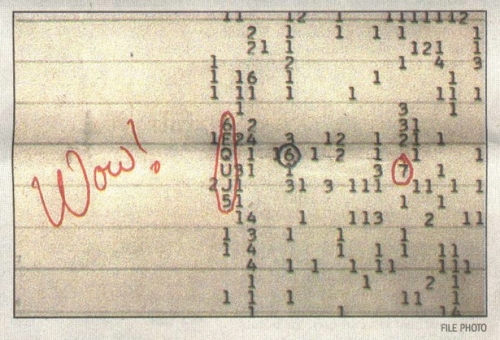
Image: The famous ‘Wow!” signal.
Here’s Gray on moving away from continuous isotropic broadcasting. I quote this passage because it places current SETI efforts in context:
…reducing the duty cycle to 1% could provide a 100-fold reduction in average power required, perhaps radiating for 1 s out of every 100 s. Searches observing targets for a matter of minutes might detect such signals, such as the Ohio State and META transit surveys which observed objects for 72 s and 120 s respectively, or Breakthrough Listen observing targets for three five minute periods…, or a targeted search such as Phoenix observing objects for 1,000 s in each of several spectral windows…, or the ATA observing for 30 minutes… Reducing duty cycle further yields further savings—for example a 10-4 duty cycle with a 104 reduction in average power might result in a 1 s signal every three hours, but most searches to date would be likely to miss such signals. Assuming longer signal duration does not help much; a 1-hour signal present every 100 or 10,000 hours would be very unlikely to be found by most current search strategies unless the population of such signals is large.
There are other ways of reducing transmission power that make sense, with repercussions for how SETI might detect them. And there are reasons for intermittency that go beyond broadcast strategies, all of which must be considered. Are there strategies that can help us here, given that our knowledge of signal duration — if indeed such signals exist — is nil? Gray suggests some possibilities that I want to look at tomorrow, as we continue to ponder intermittent signals and their possible reception.
The paper is Gray, “Intermittent Signals and Planetary Days in SETI,” International Journal of Astrobiology 4 April 2020 (abstract).

Trident: Keeping an Eye on the Triton Flyby
38 K, which translates to -235 Celsius or -390 Fahrenheit, is cold enough to allow atmospheric nitrogen to condense as surface frost, which appears to be what is happening on Neptune’s large moon Triton. This is an intriguing place, with pinkish deposits at the enormous south polar cap that are thought to contain methane ice — the color would derive from reactions with sunlight to form a variety of pink or red compounds. Moreover, there are geyser-like plumes here that leave dark streaks over the ices, some of them active when Voyager 2 flew past.
All this and Triton’s odd ‘cantaloupe’ terrain, still mysterious, and what appear to be landscape features produced by liquid eruptions from Triton’s interior. Absorbed by Triton and its mysteries for decades now, I’m all in on a Discovery Program mission concept called Trident, now under discussion at NASA (see Firming Up the Triton Flyby for my initial take on this one). It has been 31 years since Voyager’s August 25, 1989 flyby. I still have TV coverage of the event, hours of it, preserved in the now archaic VHS video tape format.
There was a bit of the New-Horizons-at-Pluto feel to the Neptune encounter, because what Triton was showing us was a young surface obviously resurfaced again and again with fresh material. Thus even then we were forced to consider what processes could drive this activity at the outer rim of the Solar System. What might be under the ice? A surviving ocean? Let’s take another look at the mission and its possibilities.
Louise Prockter (Lunar and Planetary Institute/Universities Space Research Association, Houston) is principal investigator for Trident, which would be managed at JPL:
“Triton has always been one of the most exciting and intriguing bodies in the solar system. I’ve always loved the Voyager 2 images and their tantalizing glimpses of this bizarre, crazy moon that no one understands.”
And Trident project scientist Karl Mitchell (JPL) gives a nod to the science prospects:
“Triton is weird, but yet relevantly weird, because of the science we can do there. We know the surface has all these features we’ve never seen before, which motivates us to want to know ‘How does this world work?’ As we said to NASA in our mission proposal, Triton isn’t just a key to solar system science – it’s a whole keyring: a captured Kuiper Belt object that evolved, a potential ocean world with active plumes, an energetic ionosphere and a young, unique surface.”
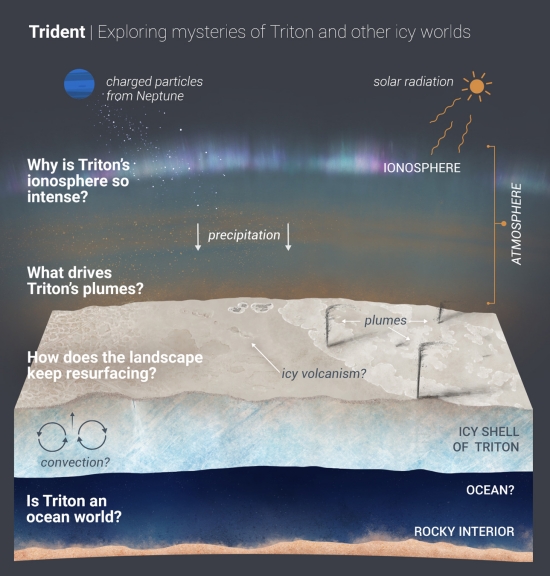
Image: A new Discovery mission proposal, Trident would explore Neptune’s largest moon, Triton, which is potentially an ocean world with liquid water under its icy crust. Trident aims to answer the questions outlined in the graphic illustration above. Credit: NASA/JPL-Caltech.
Remember, Trident is still no more than a mission concept, which means it’s in a competition, in this case with three other entrants in NASA’s Discovery Program, which complements larger flagship missions like Cassini with smaller missions having shorter development times. The other concepts: VERITAS (Venus Emissivity, Radio Science, InSAR, Topography, and Spectroscopy); DAVINCI+ (Deep Atmosphere Venus Investigation of Noble gases, Chemistry, and Imaging Plus); and Io Volcano Observer (IVO). Each of the nine-month studies receives $3 million to develop a Concept Study Report, with up to two missions selected for further development.
Given its likely origins, Triton gives us another look at a Kuiper Belt object, one that found its way into its current retrograde orbit around Neptune at an extreme tilt of 23 degrees from the planet’s equator. The moon’s ionosphere is 10 times more active than that of any other moon, an oddity given how far Triton is from the Sun. Nitrogen snows keep up a climatic churn here, while energy in the interior is produced by gravitational interactions with the parent planet. The matter is considered in this mission summary from the 50th Lunar and Planetary Science Conference (2019):
The possibility of an endogenic heat source is considered more likely over the past few years, given recent studies that have suggested sufficient heat to maintain an internal ocean. Radiogenic heating alone may play an important role, possibly providing sufficient heat to sustain an ocean over ~4.5 Ga [8]. Capture into orbit around Neptune [9, 10 and references therein] would have almost certainly resulted in substantial heating [11]; the time of capture is not constrained, but if sufficiently recent some of that heat may be preserved. Finally, despite having a highly circular orbit, Triton’s high inclination also results in significant obliquity, which should be sufficient to maintain an internal ocean if sufficient “antifreeze” such as NH3 is present [12]. Confirmation of the presence of an ocean would establish Triton as arguably the most exotic and probably the most distant ocean world in the solar system, potentially expanding the habitable zone to 30 AU.
There’s a lot of territory to explore at Triton, given that Voyager 2 data yielded a view of no more than 40 percent of its surface. If Trident flies, we’ll capture more views of the area where Voyager 2 found plumes, making for useful comparisons. The young surface may be no more than 10 million years old — note the lack of craters in the now familiar image below.
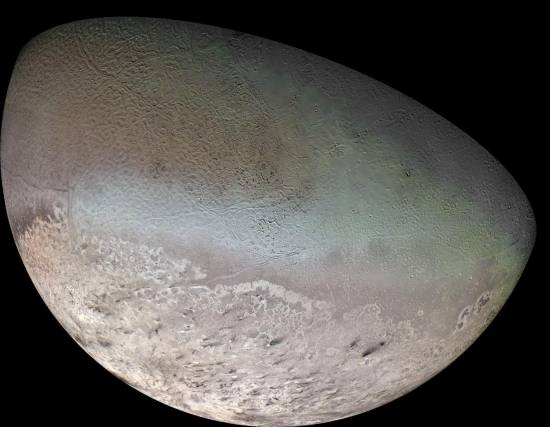
Image: Global color mosaic of Triton, taken in 1989 by Voyager 2 during its flyby of the Neptune system. Color was synthesized by combining high-resolution images taken through orange, violet, and ultraviolet filters; these images were displayed as red, green, and blue images and combined to create this color version. Credit: NASA/JPL/USGS.
Interior oceans may be the key to understanding many outer system objects, from Europa and Enceladus to Triton and perhaps Pluto itself. Trident would carry a magnetometer to probe the moon’s magnetic field to firm up or refute the ocean theory; a high-resolution mapping and compositional infrared spectrometer for characterizing surface materials; a narrow-angle camera for the largely unseen anti-Neptune hemisphere; a wide-angle camera for imaging the sub-Neptune hemisphere to look for signs of change over time; a gravity and atmospheric occultation radio system; and a plasma spectrometer to sample Triton’s outer atmosphere.
Trident would pass within 500 kilometers of Triton, actually inside its atmosphere, and close enough for high-quality magnetometer data, while passage through a total eclipse will allow atmospheric occultations. A proposed launch date is October of 2025, with a gravitational assist at Jupiter for a 2038 encounter at Triton. It would be good to make these dates, as the gravitational slingshot window with Jupiter opens only once every 13 years. This New Horizons-like mission — the concept uses heritage components and builds on New Horizons concepts of operation — has the potential to yield a similarly useful trove of data.
The mission summary I referred to above is Prockter, et al., “Exploring Triton with Trident: A Discovery-Class Mission,” 50th Lunar and Planetary Science Conference 2019 (LPI Contrib. No. 2132), available here.

Interstellar Shift: The New Horizons Baseline
“It’s fair to say that New Horizons is looking at an alien sky, unlike what we see from Earth.” Those are the words of Alan Stern (Southwest Research Institute), who is principal investigator for New Horizons. A breathtaking 7 billion kilometers from Earth, the spacecraft has just returned images showing the parallax effect for two nearby stars.
That ‘alien sky’ would look pretty much the same to the human eye except in the case of the closest stars, but the displacement of both Proxima Centauri and Wolf 359 against the deep space background is apparent in the images below. Proxima Centauri, the nearest star to our own, is shown in the top image, with Wolf 359 in the following one.
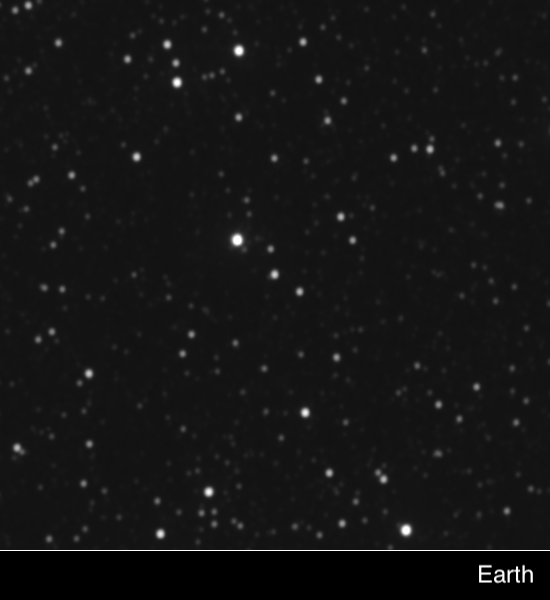
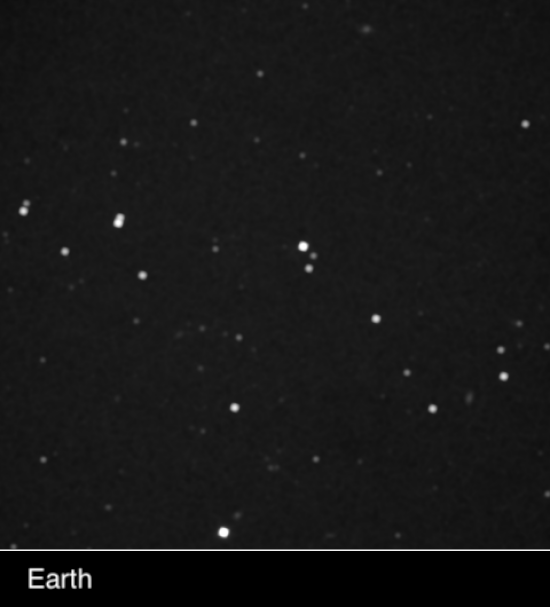
Image: This two-frame animation blinks back and forth between New Horizons and Earth images of each star, clearly illustrating the different view of the sky New Horizons has from its deep-space perch. Credit: NASA/Johns Hopkins Applied Physics Laboratory/Southwest Research Institute/Las Cumbres Observatory/Siding Spring Observatory.
This is stirring stuff. Taking parallax measurements of objects relatively nearby shows the kind of shift that first allowed astronomers to measure the distance to particular stars, beginning with 61 Cygni in 1838. That measurement was the work of Friedrich Bessel, whose attention had been drawn to the star by astronomer Giuseppe Piazzi, who had discovered its large proper motion compared to other stars. We now know that 61 Cygni has the 7th largest proper motion listed in the Hipparcos catalog, with Barnard’s Star and Kapteyn’s Star as numbers one and two.
Parallax studies like these have always involved looking at where a star is at one side of the Earth’s orbit and then at the other, but with the baseline given to us by New Horizons, we can detect the tiny shift not only with precise instrumentation but with the human eye as well. This is the largest parallax baseline ever, notes New Horizons science team member Tod Lauer (National Science Foundation), who coordinated the parallax demonstration, and who goes on to describe the images as “the first demonstration of an easily observable stellar parallax.”
But let me also quote Brian May, who often raises eyebrows when people realize that the rock guitar legend doubles as an astrophysicist and, I suspect, a science fiction fan. May worked with New Horizons deputy project scientist John Spencer (SwRI) to produce the striking images. Says May:
“It could be argued that in astro-stereoscopy — 3D images of astronomical objects – NASA’s New Horizons team already leads the field, having delivered astounding stereoscopic images of both Pluto and the remote Kuiper Belt object Arrokoth. But the latest New Horizons stereoscopic experiment breaks all records. These photographs of Proxima Centauri and Wolf 359 – stars that are well-known to amateur astronomers and science fiction aficionados alike — employ the largest distance between viewpoints ever achieved in 180 years of stereoscopy!”
I’m a great enthusiast for robotic telescope installations like the one at Las Cumbres Observatory at Siding Spring Observatory in Australia and Mt. Lemmon Observatory in Arizona, both of which were used to acquire Earth-based images of Proxima Centauri and Wolf 359, but to have the concept extended to a spacecraft at this distance from Earth is a bit mind-boggling. New Horizons needed, at the time of these observations, almost six hours and thirty minutes to get a signal home, and it will eventually exit the Solar System entirely, like both our Voyagers. An indication of the distances involved is provided by the fact that in the Proxima Centauri image, the second closest star is 120 times more distant than Proxima itself.
You’ll recall that the New Horizons team put out a call for amateur astronomers to send matching images of the two stars taken on April 22 and 23rd, with timing adjusted to the fact that New Horizons was almost three light hours closer to Proxima Centauri than Earth (and almost four light hours farther from Wolf 359) when the images were taken. You can use the hashtag #NHparallax for more, or visit this New Horizons page, where images can be downloaded in FITS format, commonly used by astronomers to preserve image fidelity while including technical data about the image, as well as readily readable 16-bit PNG format.

Destination Moon: A 70th Anniversary Appreciation
Al Jackson is back this morning with an essay examining another old friend, the 1950 film Destination Moon. Talk about fond memories! I first encountered the movie at a birthday party for a bunch of unruly 4th graders, finding the birthday boy absorbed in watching the spaceship Luna enroute to the Moon in an upstairs room while the party went on below. I stayed right there until his mother came up to scold him and bring us both back down to eat cake, dying to know what happened. Since then I’ve enjoyed the film numerous times, especially appreciating the Woody Woodpecker teaching sequence and the ingenious solution to the crew’s problems getting everyone back home. A veteran of the Apollo days and a science fiction fan with encyclopedic knowledge of the field, Dr. Jackson gives us a look at how the film was made and illuminates Robert Heinlein’s connections to the project. Time to pull out my DVD for another look.
by Albert A Jackson
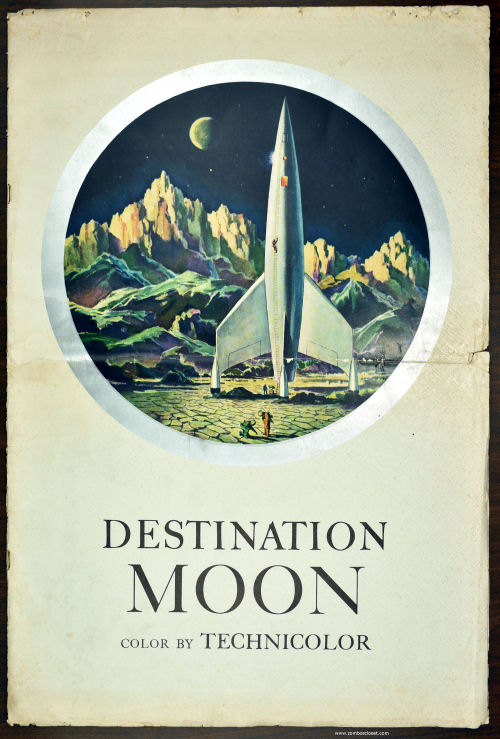
I was two weeks away from age 7 in October 1947 when Chuck Yeager flew the Bell X-1 at Mach 1 over Rogers Dry Lake in California. That really seized my mind; I read what I could about rockets and jets. I built a StromBecker wooden model of the X-1. I finally got a spaceflight book in early 1951, when I was 10: Rockets, Jets, Guided Missiles and Space Ships, by Jack Coggins and Fletcher Pratt. Quite a treasure! I did not see a copy of Bonestell and Ley’s 1949 book Conquest of Space, which would have been a bit overwhelming when I was 10, until about 20 years later.
I remember seeing an article in LIFE magazine, (April 24th 1950), for a movie called Destination Moon [1]. Later there were ads for the film that really caught my eye. There was a movie about a rocket going to the Moon with people in spacesuits. There were even radio ads that I heard. Alas, I was 10 in the fall of 1950, and my family was 2 years away from taking me and brother and sister to downtown theaters. Destination Moon may have come to a neighborhood theater in the spring of 1951 but I did not see the film until the fall of that year at a kiddie matinee. The wait was worth it, for it was a moment of transport.
Origins
Destination Moon, or something like it, probably would have been made in the late 40s or early 50s; it pretty much owes its origin to Frau im Mond, the 1929 Fritz Lang film about a trip to the Moon. Willy Ley, who had worked as an uncredited technical adviser on that Fritz Lang film, came to know Lang well. (The technical adviser on Frau im Mond was Hermann Oberth, who Ley knew. Even though Oberth studied in Munich he was from a small town and hated Weimar Berlin. Ley had to shepherd him around and act as a liaison for Lang.) Lang moved to Los Angeles after the Nazis came to power. After the end of World War II, Robert Heinlein moved back to Los Angeles. During this time Willy Ley, who Heinlein knew, would come to LA to visit Lang.
With the end of World War II, Heinlein began to develop a close interest in rockets and atomic power. He made it a personal campaign at the end of 1945 and beginning of 1946 to get the Navy interested in rockets [2, 3]. The advent of the large rocket, the V2, was on Lang’s mind too; he talked to Ley about making another movie about a spaceship to the Moon. Ley put Lang in touch with Heinlein. Lang invited the Heinleins for dinner often in 1946 and 1947. During those years. Lang and Heinlein talked about a lot of things, Heinlein was reluctant to start writing young adult novels, but Lang convinced Heinlein it would be an excellent way to connect with an audience that had an appetite for space flight. So Heinlein wrote Rocket Ship Galileo, which turned out to be a commercial success. Finally, in March of 1948 [2, 3], Lang had Heinlein huddle with him over making a film. At first Heinlein suggested Rocket Ship Galileo, but he and Lang decided they needed a more adult narrative. During this time, Lang spent a lot of time trying to convince a studio to finance a film about a trip to the Moon. None would have it. Heinlein had earlier taken on a Hollywood agent, Lou Schor, because of the need to handle possible radio adaptations of his works. When Heinlein suggested that he and Lang use his Hollywood agent, Lang had a problem with this. This led, by mid-1948, to Heinlein and Lang parting ways, though they remained friends [2, 3].
Screenplay and George Pal
Heinlein now had a ‘Hollywood bug’, likely because he had just come out of a rough financial period. Lou Schor put him in touch with screen writer Alford (Rip) Van Ronkel [2, 3]. After a week of talking, Van Ronkel suggested Heinlein write a treatment of the story. Heinlein did this, and within a few weeks handed van Ronkel a 97 page story narrative called ‘Operation: Moon’ on July 21 1948 [3]. Heinlein may have had an extensive outline in hand from his work with Fritz Lang. Using his novel Rocket Ship Galileo, Heinlein took only the narrative about an atomic powered rocket, a trip to the Moon and a crew of four, now adults (the Nazis on the Moon in the novel were removed). Some of Heinlein’s “The Man Who Sold the Moon” also diffused into the treatment. Within a few weeks, van Ronkel wrote the first draft of the screenplay for the film. Shortly thereafter, Schor arranged for Van Ronkel to be at a cocktail party where he introduced him to George Pal; there he told Pal about the screenplay. At this time Pal wanted to move from his animated “Puppetoons” into full-up film features. Also, Pal’s home studio had lost its financing. Pal was intrigued and had Heinlein and Van Ronkel come to his office for a pitch meeting [2, 3]. They struck a deal; Pal took the project to Paramount, but that studio said no [4].
Heinlein and his wife Virginia moved to Colorado Springs in the fall of 1948. Pal was striking out when it came to finding a studio when the former head of RKO, Peter Rathvon, formed his own production company, Eagle-Lion, and showed interest. He made a deal with Pal for two films, although he considered Destination Moon too speculative, so arranged things so that if it had losses, Pal would make a ‘Christmas Film’ called “The Great Rupert” to cover Destination Moon‘s shortfall at the box office. It turned out the other way around! [2, 3]
It took until May of 1949 for Pal to swing this deal. In April 1949 Heinlein finally got paid for the screen story and the rights to Rocket Ship Galileo (even though very little of the novel was to be used). Heinlein also contracted to be the technical adviser (1) for the movie. He insisted that Chesley Bonestell be hired to work on the film [3]. Heinlein and Virginia moved, temporarily, back to LA. There, he worked with the production design crew and director Irving Pichel. He found Pichel to be bright, understanding and in agreement about the story. This was good because Rathvon convinced Pal to take on another screen writer, James O’Hanlon, who rewrote the script even to the point of making it a musical, or at least inserting a musical number! (2) Thankfully almost all of O’Hanlon’s revisions were torn up by Pichel. Shooting was delayed from summer of 1949 to November so that The Great Rupert could be completed, which Pichel also directed. Principal photography on Destination Moon began on the 14th of November, 1949, and ran until roughly the 16th of December.

Image: Robert Heinlein with director Irving Pichel
Heinlein and Bonestell worked out many designs for the film. The space ship, called Luna, was initially submitted by Bonestell, and was the Lunar ship (2) in Conquest of Space by Ley and Bonestell [6], except that Bonestell (maybe consulting with Heinlein) did away with the aft V2-like fins and modified the wings. (2) Art director Ernst Fegté changed the design, keeping the central ogive and moving the wings back, the wings and a strut became part of the ‘landing gear’.
Luna is a beautiful ship and is functional enough. Bonestell made a model of the landing site, the crater Harpalus, and then a 14 foot matte lunar surface painting for the set. Pal’s production crew spent 2 months building the on-set ‘surface’. Heinlein and Bonestell were appalled when they saw it! It looked like a dried lake bed, impossible on the Moon. Pal and cinematographer Lionel Lindon decided that on a relatively small set they needed to increase the depth of field , so the added ‘cracks’. Heinlein went along with this, but Bonestell was never happy with it. Luna’s cockpit had to be designed four times in a back and forth between Heinlein and Bonestell and production design. Amazingly the cockpit was a rotating set [10], quite a feat for 1949, on a budget, (roughly 18 years before Kubrick used one, in a spaceflight movie, Kubrick and Clarke’s 2001: A Space Odyssey).
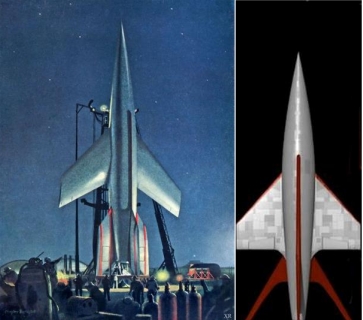
Image: At left is the ship from Conquest of Space; at right is Bonestell’s design for Destination Moon.
The Movie
The movie starts in a block house with stock footage of a V2 launch. This is the only time we see a control room, one that looks pretty good, if simplified. Heinlein was in one when he went to a V2 launch at White Sands, New Mexico in 1946 [3]. There is a ‘motor’ failure, which is a bit kludgy since Dr. Charles Cargraves ‘engine’ is supposed to be a nuclear reactor. There is talk about sabotage but it’s all kind of vague. A technician, Joe Sweeney, is about to run outside but Cargraves (3) stops him.
General Thayer later visits Jim Barnes, owner of an aircraft company, and tells him he suspects the rocket was sabotaged. Thayer wants Barnes to help Cargraves. He also speculates that the next rocket Cargraves builds will have an improved engine powered by atomic energy and could travel to the Moon. Jim is skeptical, but Thayer convinces him that the combined resources of American industry could put a rocket on the Moon within a year.
We have now been introduced to the crew that goes to the Moon: John Archer as Jim Barnes, Warner Anderson as Dr. Charles Cargraves, Tom Powers as General Thayer and Dick Wesson as Joe Sweeney. Pal, as some references say, looked for a cast of actors who were unknown but is not clear why it was B-list wooden Indians (4)! It is not Z- level movie acting but certainly near low B level. Dick Wesson is the comic-relief, an old Hollywood cliché, and it seems Heinlein went along with this. Wesson’s character plays the part of an ‘everyman’ to whom some of the scientific facts can be explained.
At a formal gathering, Jim tries to interest a consortium of industrial leaders in the project, and he shows them a Woody Woodpecker cartoon that explains how space travel could become a scientific reality. Besides teaching some basic physics, the cartoon has mission detail never mentioned elsewhere in the film, namely that when Luna returns to Earth there is some areo-breaking and a landing by parachute [1], with fins down but no full retro rocket landing.

Image: Woody Woodpecker explains rocket flight, and recovery methods on Earth.
General Thayer tells the group it is vital to global security that America be the first country to reach the Moon, warning that a foreign power could use the Moon as a missile base and thus gain control of the earth. Shades of the cold war! The industrialists fall all over themselves to finance the project. No mention is made of just which foreign power he is talking about.
When Luna is finished, Cargraves receives word that the government has denied his request to test it at the construction site, citing concerns about radioactive fallout. (Actually as I will note later, and though Heinlein would not have known it, this would have been an extremely dangerous launch.) Growing public opposition to the project leads Jim to suspect they have been targeted by a subversive propaganda campaign, and he decides to launch the rocket without waiting for permission. The crew is Cargraves, Barnes, Thayer and replacement radio man Sweeney. There is a stressful launch. High-g tests were being done by the Aeronautical Systems Center in 1948. I don’t know if there were photographs of the effects — it was not hard to extrapolate that a 5 g launch would distort the face — but this was a bit overdone in the film, and I’m not sure why Heinlein decided on 5 gs. It is notable that there are no ground control scenes, though indirectly we see what looks like a control center. We see the initial liftoff but not even a portion of the ascent. That could have been due to budget constraints. Almost all the ascent is depicted inside the ‘cockpit’.

Image: Cockpit during ascent. Couches and control panels to the right in the rotating cockpit set.
Once they are in transit to the Moon, the men don magnetic boots, which allow them to walk around in the zero g environment. Zero g had been accounted for in Frau im Mond (though in that film it never appears on screen). Destination Moon seems to be the first ‘full up’ portrayal of freefall. Those magnetic boots were a bit clunky but served their purpose.

Image: Zero g in Destination Moon.
There is a failure of the radar antenna, forcing the crew to put on spacesuits and go outside the ship to repair it. The suits are derived from pressure suits Heinlein had seen at the labs at the Philadelphia Naval Shipyard where he worked in WWII. Science fiction writer L. Sprague de Camp, also there, had been involved with this. The suits have a remarkable resemblance to some from 1943 (2a). I also think this is a better airlock in a film about space flight because the one in Frau im Mond is kind of confusing. This airlock is nicely functional.
Cargraves, of all people, loses magnetic contact with the ship and goes adrift in space (it would have been hard to train for this zero-g extravehicular activity on the ground!). He has to be rescued. The outside point of view shots are very nicely done, with some good stop-motion work with miniatures, one of Pal’s specialties. Heinlein noted that the star background was the best they could do in 1949 [10], but it looks good enough.
The ship eventually approaches the Moon, and having to account for rough terrain, they do some translating (shades of Apollo 11!) before finally touching down, though they have used more propellant than expected. This sequence starts with a beautiful outside shot of Luna rotating to a tail-down attitude with the lunar surface below. Attitude control seems to be by ‘gyro’ alone, as it seems no one thought of attitude jets. An auto-pilot is mentioned several times and seems to be in command many times. I am pretty sure all these technicalities are due to Heinlein (2a).
Cargraves and Barnes emerge from the ship to climb down a long row of retractable ladder rungs; there is some good stop-motion work here. The duo claim the Moon in the name of the United States. “By the grace of God and in the name of the United States of America… I take possession of this planet on behalf of, and for the benefit of…all mankind.” The technicalities of just how one would enforce that claim are left hanging in the vacuum.

Image: On the Lunar surface with the ‘cracks’ Bonestell hated. The full sized bottom of Luna.
The crew members conduct scientific tests, with General Thayer discovering there may be deposits of uranium on the Moon. There is some 1/6th-g action in a traverse. I am not sure but this may have been the only low-g demonstration on the Moon in a movie until recent times. Some of this was done with suited midgets on wires using forced perspective on a small lunar landscape set.
Barnes communicates by radio with Dr. Hastings at ‘mission control’ back home (we never see ‘mission control’, or Hastings, the astrodynamics guy back on Earth). Hastings confirms that their difficulties during landing used up too much of their reaction mass. Not clear why it was Barnes talking with Hastings, since Cargraves would have had more technical knowledge.
The earlier extravehicular activity (EVA), during transit, was just a minor mishap; now have a real problem to solve. Hastings instructs them to lighten the ship, and the men strip off nearly 3,000 pounds by removing metal fixtures and discarding all non-essential equipment. When Hastings tells them they must eliminate another 110 pounds, Thayer, Cargraves and Branes each volunteer to stay behind. They are about to draw lots when Sweeney sneaks out of the ship. He urges the others to leave, but Jim devises a way for them to discard the radio and the last spacesuit, thus reaching their weight goal. The ship takes off successfully, and the four men joyfully begin their journey back to Earth. Those high-g couches must have smarted without their cushions! Unlike the Earth launch more of the ascent is shown, and it is not so ‘sparky’, with better exhaust effect. One supposes they got back without having to do an EVA! Earth recovery required only a very small reaction mass (5). (The shooting script, maybe added by O’Hanlon, had scenes of domestic life with Cargraves and his wife at home. These may have been shot and then cut for the final movie).

Image: Lunar descent and ascent in the film.
Luna and Technology
It is quite striking that the spaceship in Destination Moon is single stage to the Moon and back. Heinlein had used this in his ‘kind of Tom Swiftian’ novel Rocket Ship Galileo, and it was one of the few technologies he brought over to Destination Moon from that novel. If one listens carefully when General Thayer is talking to Barnes, he mentions two numbers: an exhaust velocity of 30,000 ft/sec and a thrust of 3,000,000 pounds [1]. Exhaust velocity of 30,000 ft. per second is 9144 meters per second. Heinlein would have known that to do a single stage to the Moon, the delta V budget is 15 to 16 km/sec. Playing with the rocket equation, if one picks a mass ratio of 5 and calculates the exhaust speed, one gets about 9000 m/sec. It also implies an Isp of about 1000. No ordinary chemical fuel has a specific impulse like that. A number of guys at Los Alamos had realized that Isp was attainable with atomic energy. The first mention of an atomic rocket motor, before 1945, may have been Stan Ulam. Many technical reports came in 1945-1948 [14, 15, 16, and 17].
Heinlein knew Robert Cornog, who was at Los Alamos and would have known the skinny on nuclear rocket propulsion. Cornog had probably seen reports by Theodore von Karman and Hsue-Shen Tsien (1945) [17]), as well as Robert Serber (1946) [14], and Cornog wrote a report of his own (1945) [15]. Shepherd and Cleaver were the first to describe nuclear rockets in the open literature in 1948 [16]. Heinlein knew Cornog well and helped him keep a clearance after the war. The same calculation by Willy Ley (early 1949 [6]) is, in a roundabout way, in Conquest of Space.
The reactor in Destination Moon is never described, but it is not the rather funky Thorium one in Rocket Ship Galileo. The word ‘reactor’ is never used; it is usually ‘pile’, and the reactor seems to be a solid core. The reaction mass in the Destination Moon propulsion system is water, which would be very easy and safe to handle. The problem is that one can’t get an Isp of 1000 using water with a solid core nuclear engine. One can — I doubt Heinlein knew this — do it with a liquid core nuclear reactor (5), attaining an Isp of 1000 seconds.
Piecing together clues from the dialog in the screenplay, Heinlein’s novelette and his article in Astounding [10], some people have figured out the size and mass of Luna (5). The ship is 150 ft tall, with a ‘wet’ mass of about 250 metric tons and a dry mass of about 50 metric tons. Luna is a very good extrapolation fix-up from Rocket Ship Galileo, and not a sort of ‘hobby’ ship as in the novel. It is more planned, and put together by a SpaceX-like company without government money.
One element in the film where the government was right — Heinlein would not have known this — is that a liquid core nuclear rocket (5) has a radioactive plume coming off the reactor system which would be a cloud of death. The system would have been extremely hazardous if used in the atmosphere. The order sent to the launch site, which Barnes ignores, was thus correct. Liquid core atomic rocket engines were not proposed until 1953.
Guidance, navigation and control goes under the heading ‘automatic pilot’ in the movie, since we don’t really know, as far as I can tell, what date the flight is made (it looks like 1950). Heinlein makes the extrapolation that the electronics for doing this exists in the story. Note that Werner von Braun worked up The Mars Project in 1948 with the same kind of vacuum tube GNC systems, with no details given.
There is the use of ‘gyro’ attitude control, common to other writers about space flight at the time. Reaction jet attitude control was known in the engineering community but didn’t seem to get into science fiction. Gyro control was a favorite of von Braun also.
When it came to spacesuits (2a), Heinlein had experience with the issue during WWII at the Aeronautical Materials Lab at the Philadelphia Naval Shipyard, where he was a supervisor. L Sprague de Camp was recruited by Heinlein and was studying high altitude pressure suits. The spacesuits in Destination Moon were based on these [24]. I can only recall one movie before Destination Moon, Frau im Mond, that had spacesuits, and they were not really needed there.

Image: Pressure suits in the film on the left; on the right, a design being tested in Philadelphia in 1945.
Summary
Destination Moon is the product mainly of Robert Heinlein (6), facilitated by producer George Pal and film director Irving Pichel. Heinlein, when talking about a possible film with Friz Lang, started a reformulation of Rocket Ship Galileo into a more mature narrative. The Nazis (6) are jettisoned, and his ‘treatment’ seems reflected in the novelette he wrote of the same name [13]. After things did not work out with Lang, he wrote a treatment of his conversations with Lang and incorporated some of ‘The Man who Sold the Moon” within it. The ‘screenplay’ is online. It is all dialog, with no scene headings, action or transitions, which is odd, but probably this is just one of several script forms for the movie.
It is not clear what Pal wanted in the screenplay, but he was committed to a sort of docudrama. That’s what made the film an almost Popular Mechanics movie, so to speak. Pichel seemed to go out of his way to give Pal what he wanted. There was outside interference — the owner and CEO at Eagle-Lion, Peter Rathvon, imposed screenwriter James O’Hanlon, who inserted goofy stuff like musical numbers! (7). Pichel threw away all of O’Hanlon’s ‘script-doctoring’; there seems no record of what Pal thought of this, but he sure did not discipline Pichel. (Nor do we know what Rathvon thought of the final film which he was so nervous about).
Heinlein and Ginny returned to LA for film production in June of 1949 and remained until February of 1950. It is not clear if Heinlein advised on any of the post-production work, which was not completed until April 1, 1950. The finished film, if one could see a pristine version, looks great in Technicolor. The budget of almost $600,000 was not generous but sufficient, with hard work, to produce good special effects and production design. Heinlein was paid for the option of Rocket Ship Galileo and paid a portion for the screenplay; also, he was hired as technical consultant. I could not find what he got paid but it was enough for him and Ginny to get a start on a house in Colorado Springs [3].
Heinlein and Ginny returned to Colorado Springs in February, 1950. Patterson states the advertising and promotion of the film had a budget of $1.2 million, which is twice as much as production cost [3]. (I also found a promotion budget of $500,000 for the film [19].) Heinlein did publicity work in LA before he left, even a TV interview show with Pal and Bonestell [20]. Magazine and radio ads were everywhere and created a buzz for the movie [2, 3].
The film premiered in New York on June 27th, 1950. It seems that John W. Campbell was there, but it is not clear if Willy Ley or any of the New York Futurians attended. Bosley Crowther’s review in the New York Times was favorable, finding the film a visual treat; he was not much taken with the narrative drama. Other film reviews of the time were favorable, seemingly because of its novelty. Destination Moon made $5 million on its first run, which is almost a 3-multiplier (or a 5-multiplier if the advertising budget was 500,000), very good by modern standards.
Alas, much of profit was eaten up by coverage of the losses from The Great Rupert. The film would have made more but Eagle-Lion ran into distribution problems due to distribution control by the major studios [19]. Eagle-Lion entered into litigation for several years. Neither Peter Rathvon nor James O’Hanlon’s reaction to the film seems to be on record anywhere. Patterson’s biography does not make clear when Heinlein saw the film. He had to wait two years to get royalties for the first run, a little over $4000, and four more years before he got a small final payment [3].
Destination Moon is a bit of a quirk in film history. The public interest in science and technology was impacted by World War II, the atomic bomb, ballistic missiles, supersonic flight, radar, and the Cold War. Hollywood in 1948 was still in a mode that considered spaceflight crazy Buck Roger’s stuff. It took an independent studio and maverick producer and a science fiction grand master to get the film made.
In a way, Destination Moon was a sort of culmination of John W Campbell’s ambition to move away from pulp SF to something more sophisticated. The film is about as far away from Brass Bras and Bug Eyed Monsters as one can get. Destination Moon‘s success did not usher in a great era of space flight movies. Its competitor in 1950, Rocket Ship X-M, was actually a more interesting story although with silly engineering physics and a pulp-fiction Mars story. Pal followed with a film based on the second rate SF novel When Worlds Collide, and we got the totally goofy, pulpish Flight to Mars in 1951.
There were some weak efforts after 1951. Heinlein had a possible TV series called The World Beyond, but the pilot was released as a poorly financed movie called Project Moon Base. Pal’s 1955 Conquest of Space was the last serious space flight movie of the 1950’s. Alas, even though technically pretty good, James O’Hanlon seemed to get his revenge with a sappy story for the film. Then followed a torrent of schlock SF, awful films most of which were not even up to bad pulp standards! (8)
Destination Moon is a unique film. It took 18 years before there was a film with the same factual rigor, and probably more — that was 2001: A Space Odyssey. Destination Moon was influential; I know it impacted my life. When I was 11, I had no idea who Robert Heinlein (9) was. A year later I was reading his young adult novels. Almost simultaneously, in 1952, the Colliers series on spaceflight came out, then the Disney TV series. I could not imagine, at the time, that I was headed toward participating in Apollo and the first lunar landing. Looking back I am still a bit amazed.
Notes
1. At one point Heinlein suggested a backup technical adviser, Jack Parsons. That was odd; Parsons only real knowledge was rocket propellants. At that time, there were three guys from CalTech who Parsons knew and they were young and significant experts in spaceflight: Frank Malina, Martin Summerfeld and Hsue-Shen Tsien. Apparently Heinlein met Tsien but not Malina or Sommerfeld. They were all in LA at the time. Malina was an SF fan and expert in the new field of spaceflight, but apparently Heinlein never met him.
Chesley Bonestell did some technical advising on the film.
It is not clear if Pal agreed with Rathvon’s interference. Pal had wanted a documentary-style film and he had it in hand. Adding O’Hanlon meant some money when to him.
Heinlein wrote Willy Ley asking technical questions. Ley was not happy about this. He wrote back an angry letter asking to be paid for consulting. At the time Ley was strapped for money; I also wonder if he was a bit upset that he had been a facilitator of the whole course of events, since Conquest of Space seemed to be an input to the movie too. Heinlein tried to smooth things over but Ley remained unhappy [5]. In the 1954 edition of Rockets, Missiles, and Space Travel, Ley has a footnote about Destination Moon, saying he liked the film and praising its technical information [7].
Heinlein also consulted astrophysicist Fred Zwicky at CalTech and Robert S Richardson, an astronomer at Palomar Observatory and an SF author. Richardson did some detailed astrodynamics for Heinlein for Destination Moon.
2. Luna shows up in at least one or two more films, but Bonestell’s modified Conquest of Space ship is copied an uncountable number of times in movies [8, 9]. It shows up next in the 1951 Flight to Mars, and in modified versions on Tom Corbett Space Cadet and other TV shows.
2a. The spacesuits were suggested by Heinlein [3]. Like Luna, they were copied in other movies and TV shows many times. Color coding on uniforms and other similar clothes was not new, but the film used it to good advantage and it enhanced the Technicolor. It’s interesting that years later Kubrick used the same suit colors in 2001: A Space Odyssey, with the commander in red and the 2nd in command in yellow, with blue suits for the other crew and green for the suit in the emergency entrance [8].
Werner von Braun had, in 1948, vacuum tube guidance, navigation and control technology in the mission design for his Mars Project.
3. Cargraves is the only character carried over from Rocket Ship Galileo. The name seems to be a play on the name of Sir William Congreve, a 19th century military solid rocket pioneer.
4. Pal was looking to keep the budget down. It is not clear why he picked these actors or if Pichel could have gotten better performances. Pichel as veteran actor could have doubled as a character himself. Across town, Lippert Pictures made a film to piggyback on Destination Moon‘s publicity campaign, Rocket Ship X-M, (where M is Moon). The screenplay by Dalton Trumbo is full of scientific howlers but the story is not as awful as the 1953 Cat Women of the Moon (or other Z movies of the 50s). On a budget of $94,000, Lippert hired good actors like John Emery and Noah Beery, Jr., as well as Lloyd Bridges and Hugh O’Brian. These guys sure would have been an improvement in Destination Moon even with the same dialog.
Heinlein found out about Rocket Ship X-M through a letter from L. Ron Hubbard. Hubbard claimed to be working on that film, though as far as can be determined, he had nothing to do with it [2,3]. How Pal’s film became known to Lippert is not known, although Heinlein had informed Forest J Ackerman about Destination Moon‘s greenlighting in May of 1949. Destination Moon seems to have become known to fans in the LA area in early 1949. It is odd that Lippert even put up $94,000 when all the majors were nervous about a movie Moon-trip story.
5. Winchell Chung at the web site Atomic Rockets has the best summary, with some massaged numbers to make the dynamics of Luna work better. I think he is the first to notice that using water as the reaction mass requires a liquid core nuclear reactor [18].
6. Heinlein in his prose was an accomplished storyteller and good at writing dialog. The novelette Destination Moon has better dialog, though not polished. The basic story feels guided by Heinlein’s hand but in a very strict narrative. He wanted a no-nonsense story line and that is what results.
In the novelette Destination Moon, ‘domes’ are found, supposedly Russian. I doubt this was in any version of the screenplay. Nazis on the Moon became a pop-idea that would not die. This is what the film Iron Sky (2012) was about.
7. Pal must have had a weak spot for this; in the 1955 film Conquest of Space, O’Hanlon inserted a televised musical number by Rosemary Clooney to the space station.
8. Ley finally got some money from Pal by selling him the rights to Conquest of Space, which had no film story in it [4]. Conquest of Space seems to have had no technical adviser, although director Byron Haskin is quoted as saying he talked to Werner von Braun a lot [21]. However, there is a picture of Pal, Bonestell, Ley and director Haskins around a large table with Ley expounding on technical issues.
The movie Conquest of Space, aside from the narrative, is an odd mix of von Braun, Ley and Bonestell’s popularization of space flight by way of the Collier’s series, von Braun’s The Mars Project and the book The Exploration of Mars. An April 1954 issue of Collier’s (the last issue of the spaceflight series) had a full realization of the 1948 von Braun Mars Project. Ley and Bonestell were pressuring von Braun to make a book of this. However, von Braun wanted to redesign the expedition, taking the Mars fleet down from 10 ships to 2. The movie Conquest of Space took it down to 1. Most of the rest of the design was from the Collier’s series: The space station, the spacesuits, the orbital ferries and the Mars ship. Somehow some retrorockets got added to the Mars ship; I doubt that was von Braun’s design.
I could not find a single reference that related what Wernher von Braun thought of Destination Moon.
Except for Destination Moon and Conquest of Space, I don’t think a single spaceflight movie in the 1950s had a technical adviser.
9. Reading several essays about Destination Moon it is strange how Heinlein’s involvement is either not mentioned or touched upon only briefly. The Moon flight film would have never been made if it had not been for Ley’s introduction to Lang, after Heinlein broke with Lang, and if Heinlein had not persisted with the story and screenplay in 1948.
10. Arthur C. Clarke had mentioned atomic propulsion in 1945 [22] and had written a novel, Prelude to Space in 1947 [23], which used a nuclear powered two stage vehicle.
References
1. Destination Moon, screen play by Rip Van Ronkel, Robert Heinlein and James O’Hanlon, from a novel by Mr. Heinlein; directed by Irving Pichel; produced by George Pal and released by Eagle-Lion. (Premiere: June 29 1950).
2. Patterson, William H., Jr. 2010. Robert A. Heinlein in Dialogue With His Century: 1907-1948 Learning Curve. An Authorized Biography, Volume I.
3. Patterson, William H., Jr. 2014. Robert A. Heinlein in Dialogue With His Century: 1948-1988 The Man Who Learned Better. An Authorized Biography, Volume II.
4. Gail Morgan Hickman, The Films of George Pal, A. S. Barnes and Co., Inc., 1977.
5. Jared S. Buss, Willy Ley: Prophet of the Space Age. University Press of Florida, 2017.
6. Willy Ley and Chesley Bonestell, The Conquest of Space. New York: Viking, 1949.
7. Willy Ley, Rockets, Missiles, and Space Travel, Viking Press, 1954.
8. Jack Hagerty and Jon C. Rogers, Spaceship Handbook, ARA Press, October 1, 2001.
9. Ron Miller, The Dream Machines, Krieger Pub Co, July 1, 1993.
10. Robert Heinlein, Shooting Destination Moon, Astounding Science Fiction, July 1950.
11. Robert A. Heinlein, Rocket Ship Galileo, Scribner’s, May 1, 1947.
12. Alford Van Ronkel, Screenplay for Destination Moon,
https://www.scripts.com/script/destination_Moon_6783
13. Robert A. Heinlein, “Destination Moon,” Short Stores Magazine, September 1950.
14. Robert Serber, “The Use of Atomic Power for Rockets,” Project Rand, RAD-2, July 5 1946.
15. R. Cornog, “Rocket Computations,” NEPA-508, August 3, 1946.
16. L. R. Shepherd and A.V. Cleaver; “The Atomic Rocket 1 and 2,” Journal of the British Interplanetary Society, volume 7, no. 5 and 6, 1948.
17. H. S. Tsien; “Rockets and Other Thermal Jets Using Nuclear Energy,” Chapter 11 of The Science and Engineering of Nuclear Power, volume II, edited by Clark Goodman, Addison Wesley Press, Cambridge, MA., 1949.
18. Winchell Chung, Luna from Destination Moon, http://www.projectrho.com/public_html/rocket/
19. Bradley Schauer, “The Greatest Exploitation Special Ever: Destination Moon and Postwar Independent Distribution,” Film History An International Journal 27(1):1-28, 2014.
20. https://www.youtube.com/watch?v=wOZyoJKltKI
21. Thomas Kent Miller, Mars in the Movies: A History, McFarland, 2016.
22. Arthur C. Clarke, “Extraterrestrial Relays,” Wireless World October, 1945.
23. Arthur C. Clarke, Prelude to Space, World Editions, 1951.
24. Dennis Jenkins, ‘Dressing for altitude: U.S. aviation pressure suits – Wiley Post to space shuttle,” NASA SP; 2011-595, 2012.


